10 years of EIMI: “Completing a mosaic“
In 2017 the European Institute for Molecular Imaging celebrated not only its tenth anniversary but also the appointment of Friedemann Kiefer as Professor of Intravital Molecular Imaging. How did the institute develop over the first ten years? What were special moments? In this interview the directors of EIMI – Prof. Michael Schäfers, Prof. Andreas H. Jacobs and Prof. Friedemann Kiefer – reflect on these ten years.
Photos
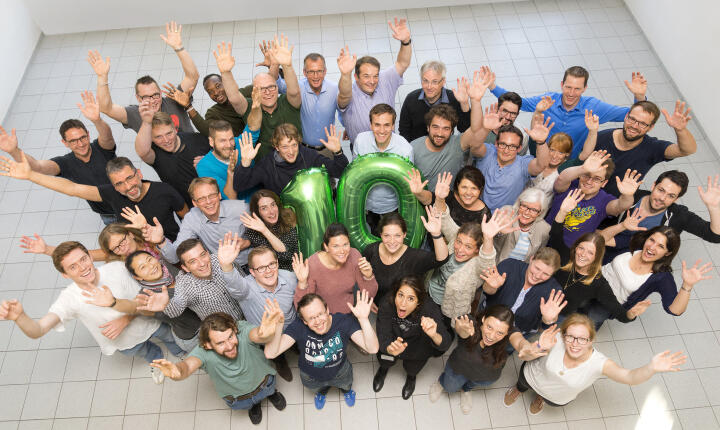

At a symposium on December 5th, 2017, Prof. Michael Quante (Prorector for International Affairs and Transfer) and the Deans Prof. Mathias Herrmann (Faculty of Medicine), Prof. Uwe Karst (photo, Faculty of Chemistry and Pharmacy) and Prof. Gerhard Wilde (Faculty of Physics) congratulated.© EIMI/M. Kuhlmann 
The Dean of the Faculty of Mathematics and Computer Science, Prof. Xiaoyi Jiang, could not attend personally and sent his congratulations to EIMI Director Prof. Michael Schäfers and his colleagues via video message.© EIMI/M. Kuhlmann 
The initiator of EIMI, Prof. Otmar Schober, …© EIMI/M. Kuhlmann 
… and founding partner Dr. Hartwig Newiger (Siemens Healthineers) looked back on the beginnings of EIMI.© EIMI/M. Kuhlmann 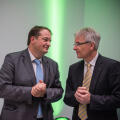
Michael Schäfers (left), who has been part of the EIMI from the beginning, gave a review of the past ten years. Friedemann Kiefer (right) gave his inaugural lecture entitled "Trying to Cross the Second Valley of Death in Imaging".© EIMI/M. Kuhlmann 
In a keynote lecture, Prof. Peter Mortimer (University of London) gave insights into his research on diseases of the lymphatic system.© EIMI/M. Kuhlmann 
The guests had many good conversations around the symposium.© EIMI/M. Kuhlmann 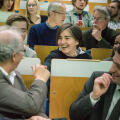
Impressions from the symposium marking EIMI’s 10th anniversary© EIMI/M. Kuhlmann 
Impressions from the symposium marking EIMI’s 10th anniversary© EIMI/M. Kuhlmann 
Impressions from the symposium marking EIMI’s 10th anniversary© EIMI/M. Kuhlmann 
And that's how it all started: The EIMI was established in 2007 at the University of Münster, with support from Siemens. Prof. Michael Schäfers (left), a specialist in nuclear medicine, was appointed Professor of Technology and Imaging. From right: Founding Director Prof. Otmar Schober, Prof. Erich Reinhardt (Siemens), Prof. Jürgen Schmidt, the Rector of Münster University at that time, and the then Dean of Research, Prof. Eberhard Schlatter.© EIMI/M. Kuhlmann 
In 2010 Prof. Andreas Jacobs, a neurologist, was appointed Professor of Target Biology and Target Chemistry.© EIMI/M. Kuhlmann 
Thematically, the EIMI has close connections with the Department of Nuclear Medicine at Münster University Hospital (UKM). In 2013 the two institutions grew even closer together: Michael Schäfers (left) took over the office of Director, as Otmar Schober’s successor. The picture shows the symbolic handover of the baton with the Medical Director of Münster University Hospital at that time, Prof. Norbert Roeder, and the Executive Officer of the Medical Faculty, Dr. Elke Williamson.© EIMI/M. Kuhlmann 
The EIMI team develops and uses imaging methods for research into processes inside the body. In the first few years the laboratories were located …© EIMI/M. Kuhlmann 
… in the „Technologiehof“ on Mendelstraße in Münster.© EIMI/M. Kuhlmann 
In those days the EIMI logo looked different from what it does today.© EIMI/M. Kuhlmann 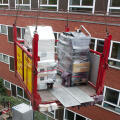
In 2014 the team moved to Waldeyerstraße in Münster. The sensitive high-performance equipment used in research – such as the PET and CT scanners seen here – were carefully transported by crane onto the first floor.© EIMI/M. Kuhlmann 
The same building also houses the institute headed by biochemist Prof. Lydia Sorokin. Since 2012, Michael Schäfers has been leading the Cells-in-Motion Cluster of Excellence together with Sorokin and biochemist Prof. Volker Gerke. The close proximity of the teams to one another makes close collaboration easier in the research work they are engaged on.© EIMI/M. Kuhlmann 
The laboratory equipment at the EIMI has grown over the years. In 2013 the team installed a combined ultrasound and photoacoustic system, …© EIMI/M. Kuhlmann 
… in 2015 a small-animal PET-MRI …© EIMI/M. Kuhlmann 
… and in 2017 a two-photon microscope.© EIMI/M. Kuhlmann 
The EIMI team is also engaged on joint tasks over and above its research work – here at a retreat in 2015. © EIMI/M. Kuhlmann 
On such occasions, everyone enjoys getting together after work …© EIMI/M. Kuhlmann 
… or making music together – here at the Christmas party in 2010.© EIMI/M. Kuhlmann 
The EIMI team in 2011 …© EIMI/M. Kuhlmann 
… an in 2015.© EIMI/M. Kuhlmann
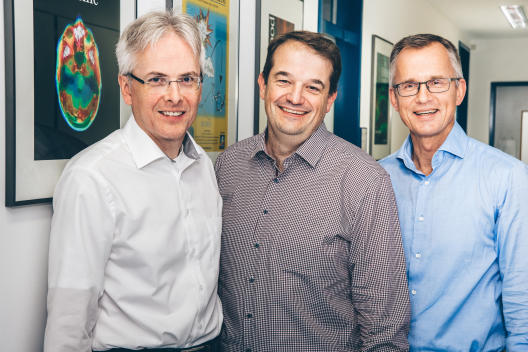
When EIMI was established, a press release given out at the time spoke of the “first European Institute for Molecular Imaging”. Prof. Schäfers, you were there from the beginning. What was so special about the establishment of EIMI?
Michael Schäfers: At that time there was no institute in Europe that combined basic research and clinical applications in molecular imaging. For the majority of cases, molecular imaging was part of clinical research and application, mainly established through nuclear medicine methods applied in patients. However, we wanted to expand these methods to preclinical research, extend the scope of imaging methods – for example, by including optical imaging – and create a link between basic research and clinical application.
The initiator and spiritus rector of EIMI, Prof. Otmar Schober, had the vision of establishing an international centre – and we wanted this to be reflected in the institute’s name. Today, I think we can say that we have succeeded in that. The team working at the EIMI is international and there are a large number of international collaborations. We laid the foundations for the EIMI in 2005 with the Collaborative Research Centre 656 – Molecular Cardiovascular Imaging. The result of this was that, for the first time, our research became visible outside the University of Münster.
So visible, that Siemens agreed to provide funding for EIMI.
Michael Schäfers: That really was a great opportunity for us. The former CEO of Siemens Medical Imaging, Prof. Erich Reinhardt, recognized how unique the idea for the EIMI was, and Siemens became our founding partner. For eight years, the company provided financial support in the form of two endowed professorships – that of Andreas Jacobs and mine. After the funding came to an end, the University granted both professorships permanently. That’s how the institute gradually developed.
Andreas Jacobs: And, of course, it was a perfect basis for all further projects. In addition to funding from Siemens and the German Research Foundation, we succeeded in acquiring substantial funding from the Federal Ministry of Education and Research and from the EU.
At EIMI, researchers from a wide spectrum of disciplines work together – including biomedical scientists, chemists, physicists, mathematicians and computer scientists. How important is this interdisciplinary collaboration for your research?
Friedemann Kiefer: It’s only through the collaboration of researchers from these different disciplines that we succeed in developing our molecular imaging approaches further, such that we will obtain a better understanding of physiology and pathophysiology. We try to identify key molecules, which can inform about physiological and pathological processes in the body. We want to visualize these molecules, which needs new technologies. In such interdisciplinary projects, our PhD students are supervised by representatives from various disciplines. This stimulates the students’ scientific curiosity as they experience approaches taken by other disciplines. In this way, these excellent junior researchers can develop their full potential.
Andreas Jacobs: What’s exciting in the whole process is that individual disciplines constantly learn from one another. In discussions with PhD students you experience that everyone is excited about the research being done by the others. Many projects are only initiated because we all look beyond our own boundaries and try to approach questions from a different perspective or by using other methods.
Michael Schäfers: And this makes the atmosphere at the institute so lively. Colleagues are very open with one another, and I think this atmosphere has even spread beyond EIMI.
What factors contributed to the success of the concept?
Friedemann Kiefer: I think for one thing it was the fact that Otmar Schober and his colleagues had an overarching long-term vision. And, in connection with that, people were prepared to be patient and did not immediately expect great results after three years.
Michael Schäfers: Yes, that gave us time first of all to develop a common language between the individual disciplines. Today, of course, as a specialist in nuclear medicine I’m still not a chemist, and I don’t know for example how to plan and carry out syntheses myself. But I can understand what happens in chemistry – and the same is true vice-versa. That is a continuous process: ultimately, in any interdisciplinary exchange every new member in a team first has to adapt to the language of other disciplines.
Andreas Jacobs: What we’ve also managed to do over time is to convince individual faculties to get involved in such a concept – in other words, to build trust and remove any doubts. Everyone benefits from working together.
What were the particularly remarkable moments in the past ten years?
Michael Schäfers: One really significant moment for me personally was when our Collaborative Research Centre (CRC) reached the maximum possible funding period of twelve years. EIMI certainly played a decisive role in this because it was able to form a core for the CRC, from the point of view of structure and staff. At the same time, EIMI was also a driver as far as the approval for the Cells-in-Motion Cluster of Excellence in 2012 was concerned, in which interdisciplinary collaboration is now practised to a much wider extent.
Friedemann Kiefer: We were naturally delighted when the decision was taken to build the Multiscale Imaging Center, the MIC. We expect that from 2019 teams from all fields of imaging at the University will be undertaking research in one building.
Andreas Jacobs: As far as the technologies are concerned, the past few years were like completing a mosaic in which we were gradually able to insert more and more pieces, i.e. imaging methods. We started off with the PET and SPECT methods from nuclear medicine, along with computer tomography. Then, with my appointment in 2009, among other things, optical imaging was introduced at EIMI. Then followed ultrasound and, in 2013, photoacoustic imaging. Later we carried out our first investigations using two-photon microscopy – and now, with the appointment of Friedemann Kiefer, we have expanded and further completed the range of live imaging approaches.
This is a new professorship for Intravital Molecular Imaging. Prof. Kiefer, what is the importance of this for the institute?
Friedemann Kiefer: I primarily use microscopic methods to examine molecular processes at the cellular level – in order to gain a better understanding of the consequences for entire organs or for the organism. This focus – light microscopy – has so far been lacking at EIMI. There is still a large gap between scientists engaged in basic research, who observe processes under the microscope with cellular resolution, and scientists who in most cases have a more preclinical or clinical orientation and who work with whole-body imaging. What we want to do is combine our findings at various biological scales and, by doing so, learn to understand what these findings from the ’world of cells‘ mean for the larger scales of organs and organisms.
What plans do you have for the future?
Michael Schäfers: When we move into MIC we’ll be closer to other teams and institutes. We’ll be able to work even more closely with individual faculties just by having them near.
Friedemann Kiefer: EIMI will be an important organ in the MIC organism.
Michael Schäfers: One of our aims is to continue to acquire funding for lots of exciting projects. In 2017, the EIMI was amongst the top institutes at the Faculty of Medicine with the most third-party funding from the German Research Foundation. This shows that our research is competitive and relevant. On top of that, we want to continue discovering new research paths, of course.
Does that mean involving even more disciplines?
Friedemann Kiefer: Absolutely – in the natural sciences, new interdisciplinary directions are opening up in basic research. Biomechanics is one field, which we will be integrating, and which is already producing some fascinating results showing how biomechanical influences reprogramme and change the cardiovascular system.
Andreas Jacobs: Or engineering is needed to produce artificial tissues synthetically. This has only started.

